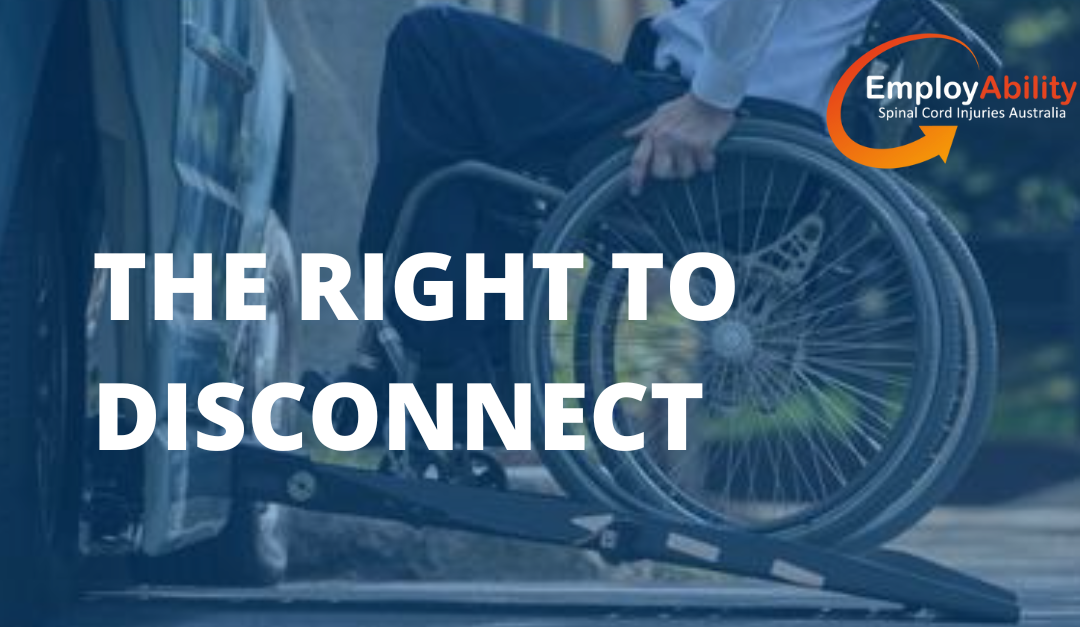
Australia’s newly implemented ‘Right to Disconnect’ law, effective from August 2024, is a significant step toward ensuring a healthier work-life balance for all employees. This legislation is particularly beneficial for people with disabilities, as it addresses unique challenges they face in the workplace.
Systemic Advocacy and Social Impact Manager, Suzie Stollznow, at SCIA sums this benefit up nicely in one simple sentence “Flexibility benefits Disability”.
Organisations such as the Fair Work Ombudsman, Diversity Council Australia, and the University of Sydney have responded positively to the new ‘Right to Disconnect’ legislation, highlighting its potential to reduce stress and burnout, promote equal treatment, and enhance work-life balance for people with disabilities.
Reducing Stress and Burnout
For people with disabilities, constant work-related communication outside of office hours can exacerbate stress and burnout, particularly when managing chronic conditions. The Fair Work Ombudsman cites that the ‘Right to Disconnect’ allows them to rest and recuperate without the pressure of responding to work demands during personal time. This is essential for maintaining both physical and mental health.
Promoting Equal Treatment
The law emphasises that refusal to engage in after-hours work communication should not be unreasonable based on personal circumstances, including caregiving responsibilities. This is crucial for people with disabilities who may require more time to manage their health or depend on assistive services that operate on strict schedules. (ref: Diversity Council Australia)
Enhancing Work-Life Balance
For employees with disabilities, a balanced work-life dynamic is crucial. The ability to disconnect ensures that they have adequate time to engage in personal activities, therapy, and social interactions, fostering overall well-being and reducing the risk of isolation. (University of Sydney (2024)
Protecting Employment Rights
The new law safeguards the rights of people with disabilities by creating clear boundaries between work and personal life. This helps prevent the erosion of these boundaries, which has been a growing concern in the era of remote work. Employees are now more empowered to advocate for their rights without fear of retribution.
Australia’s ‘Right to Disconnect’ is a progressive step that will benefit all workers, but its impact on people with disabilities is particularly profound, offering them much-needed support to thrive both personally and professionally.
But are there any negatives for PWD?
While Australia’s new ‘Right to Disconnect’ law offers significant benefits, potential downsides have been raised. Connecticut Public, a news outlet covering labor and legal issues, and DLA Piper, a global law firm providing insights on employment law, have highlighted concerns about the implementation and impact of this legislation.
Ambiguity and Disputes
The law includes exceptions where refusal to respond after hours might be deemed unreasonable, such as in emergencies or based on the employee’s seniority. In an article published on Connecticut Public (2024), the author suggests this can lead to ambiguity and disputes over what constitutes “reasonable” after-hours work, potentially increasing tensions between employers and employees.
Impact on Career Progression
According to DLA Piper (2024), there is a concern that employees who strictly adhere to the right to disconnect might be perceived as less committed, potentially affecting their opportunities for career advancement. This could disproportionately affect people with disabilities if their need to disconnect is misinterpreted as a lack of dedication.
—————————————————————
These challenges highlight the importance of clear communication and balanced expectations to ensure the law achieves its intended benefits without unintended negative consequences.
Sources:

